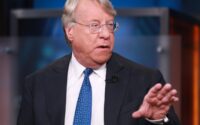UBS Favours Quality Bonds, Stocks In 2024

UBS Global Wealth Management’s chief investment office has just released the UBS Year Ahead 2024 report, outlining what investors should expect as they enter, what it set out to be, “a new world.”
UBS
Global Wealth Management”s chief investment
officer believes that the strength of the US economy in 2023
is likely to give way to slower, though still positive, growth
in 2024, while UK and European growth should remain subdued.
China will also enter a “new normal” of lower, but potentially
higher quality growth.
The firm believes that central banks will start their
interest rate cutting cycles next year. Politics will also
have an outsized role in 2024, with the upcoming US elections,
and ongoing geopolitical tensions and wars.
Mark Haefele, chief investment officer at UBS GWM, said that this
environment speaks in favour of tilting equity allocations
towards quality stocks, including in the technology sector, which
can deliver earnings’ growth even against a backdrop of slowing
global growth.
Paul Donovan, chief economist at UBS GWM, expects
central banks to start cutting rates in 2024. He said that the
rate cuts will start a little bit earlier in the UK, perhaps as
early as May, as the UK is more interest-rate sensitive, and
mid-year in the rest of Europe and the US. Nevertheless,
markets are pricing in that the Bank of England is likely
to cut rates after the European Central Bank and the Federal
Reserve.
In UBS’ view, government bond markets are overpricing the risk
that high interest rates will represent the new normal, and it
also expects yields to fall in 2024. This speaks in favour of
limiting cash allocations and locking in yields in quality bonds.
Haefele also expects politics to have an outsized role in 2024.
The US presidential election, the Israel-Hamas and Russia-Ukraine
wars, and the continuing rivalry between the US and China could
all have global market repercussions. And political decisions to
engage in large and unfunded fiscal spending create both upside
and downside investment risks for base case economic
forecasts.
“Investors should prepare to hedge market risks. We see capital
preservation strategies, macro hedge funds, oil, and gold as
hedges to focus on in 2024,” Haefele said.
Looking at the decade ahead, he expects the effects of AI,
China’s maturing economy, the energy transition, and high global
debt levels to grow larger still. He thinks that AI will spur
meaningful value creation across a range of sectors. For now,
investors have focused on the likely beneficiaries from AI
hardware and platforms, but the potential spillover into
applications will reach far and wide.
Climate change
Haefele believes that concerns about climate change and national
security will drive a global transition towards decarbonisation.
Achieving a complete transition to a carbon-zero economy is a
complex undertaking. But significant investment in
decarbonisation projects should mean high growth potential for
solution providers in the space.
Government investment in technological, environmental, energy,
and physical security – as well as ageing populations –
means that debt levels are likely to rise. He believes that
higher debt levels will contribute to higher volatility in fixed
income, but also more opportunities for private investors to
supply financing. These trends speak to the importance of
building alternative assets into diversified portfolios for
investors who are able to manage the specific risks associated
with them.
Haefele expects positive returns for balanced portfolios in 2024;
the firm’s scenario analysis suggests that multi-asset
diversification should also prove effective at hedging risk
scenarios. Over the longer term, he believes that investors who
keep a diversified multi-asset portfolio – traditional or
sustainable – as a “core” investment strategy are most likely to
successfully protect and grow real wealth over time.
Quality bonds
Themis Themistocleous, chief investment officer EMEA
at UBS GWM, thinks slower growth will lead to lower
interest rate expectations, and lower yields in 2024, making
high-quality bonds an attractive investment opportunity.
He believes that it is an opportune time to add to
high-quality bonds – specifically high grade (government) and
investment grade. Current yields should provide attractive
returns, with positive returns possible across a range of
scenarios, particularly in downside economic scenarios.
UBS sees value in the one- to 10-year duration segment, and
particularly the five-year duration point. It believes that this
middle part of the yield curve offers an appealing combination of
higher yields and greater stability than the longer end, as well
as some sensitivity to falling interest rate expectations.
UBS is more cautious on longer-term bonds due to their greater
sensitivity to technical factors, including currently high
Treasury supply.
The firm sees select opportunities in riskier credit
segments, including high yield credit and emerging market bonds.
However, tighter lending standards, higher refinancing costs, and
slower economic growth suggest higher default risks. Liquidity
risk premiums may also rise as global money supply shrinks. As a
result, UBS considers high yield spreads to be vulnerable to
widening, relative to investment grade and high grade.
Themistocleous also expects more upside for quality bonds in 2024
than equities.
Quality stocks
UBS predicts that equity markets will rise broadly, but
particularly quality companies, including those in the technology
sector, with the potential to grow earnings against a backdrop of
less robust economic activity. In particular, it favours the AI,
healthcare and climate change sectors. Regionally, UBS likes
emerging market equities and views UK equities as least
preferred.
Meanwhile, Dominic Schnider, head global FX and commodity
at UBS GWM, expects the dollar to remain stable
going into the first quarter of 2024, and then to weaken as US
growth falls. He recommends making use of the Australian dollar
in 2024 when the US dollar declines.
[ad_2]
Source link


